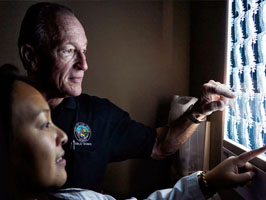Vertebroplasty and kyphoplasty are minimally invasive procedures used to treat vertebral compression fractures (VCF) of the spine. These painful, wedge-shaped fractures can be caused by osteoporosis and injury. Left untreated, they can lead to a humped spine (kyphosis). By restoring the vertebra height with a balloon and injecting cement into the fractured bone, patients can recover faster and reduce the risk of future fractures.
What are vertebroplasty & kyphoplasty?
In vertebral compression fractures (VCF), the body collapses into itself (more in the front than the back) producing a "wedged" vertebra. When several vertebrae become wedge-shaped, people can develop a humped spine, called kyphosis. People with bones weakened by osteoporosis (a depletion of calcium) or multiple myeloma (cancer of the bone marrow) are especially prone to compression fractures. Activities, such as lifting a heavy object, sneezing, or coughing may cause fractures. VCFs can lead to back pain, reduced physical activity, depression, loss of independence, decreased lung capacity, and difficulty sleeping.
Vertebroplasty and kyphoplasty are similar procedures. Both are performed through a hollow needle that is passed through the skin of your back into the fractured vertebra. In vertebroplasty, bone cement (called polymethylmethacrylate) is injected through the hollow needle into the fractured bone. In kyphoplasty, a balloon is first inserted and inflated to expand the compressed vertebra to its normal height before filling the space with bone cement. The procedures are repeated for each affected vertebra. The cement-strengthened vertebra allows you to stand straight, reduces your pain, and prevents further fractures.
Without treatment, the fractures will eventually heal, but in a collapsed position. The benefit of kyphoplasty is that your vertebra is returned to normal position before the bone hardens. Patients who've had kyphoplasty report significantly less pain after treatment.
Studies show that people who get one osteoporotic fracture are 5 times more likely to develop additional fractures. It is important that people seek treatment for osteoporosis early, before fractures occur.
Who is a candidate?
Vertebroplasty or kyphoplasty may be a treatment option if you have painful vertebral compression fractures from:
Osteoporosis (a depletion of calcium in bones)
Metastatic tumor (cancer spread from another area)
Multiple myeloma (cancer of the bone marrow)
Vertebral hemangioma (benign vascular tumor)
You may not be a candidate if you have:
Non-painful stable compression fractures
Bone infection (osteomyelitis)
Bleeding disorders
Allergy to medications used during the procedure
Fracture fragment or tumor in the spinal canal
Vertebroplasty and kyphoplasty will not improve old and chronic fractures, nor will they reduce back pain associated with poor posture and stooping forward. Traditional treatment used to involve waiting 4 to 6 weeks to see if patients improved on their own, but now it's believed that waiting allows the bone to harden, making vertebroplasty or kyphoplasty less effective. Many doctors are now suggesting vertebroplasty as soon as the first week after a fracture for some patients because the results are significantly better.
The Surgical Decision
The surgeon will perform a complete medical history and physical exam. Diagnostic studies (MRI, CT, bone scan) may be included in your evaluation to make a diagnosis of vertebral compression fracture. Your surgeon will also determine if your spine is "stable" or "unstable" and will discuss with you all treatment options.

